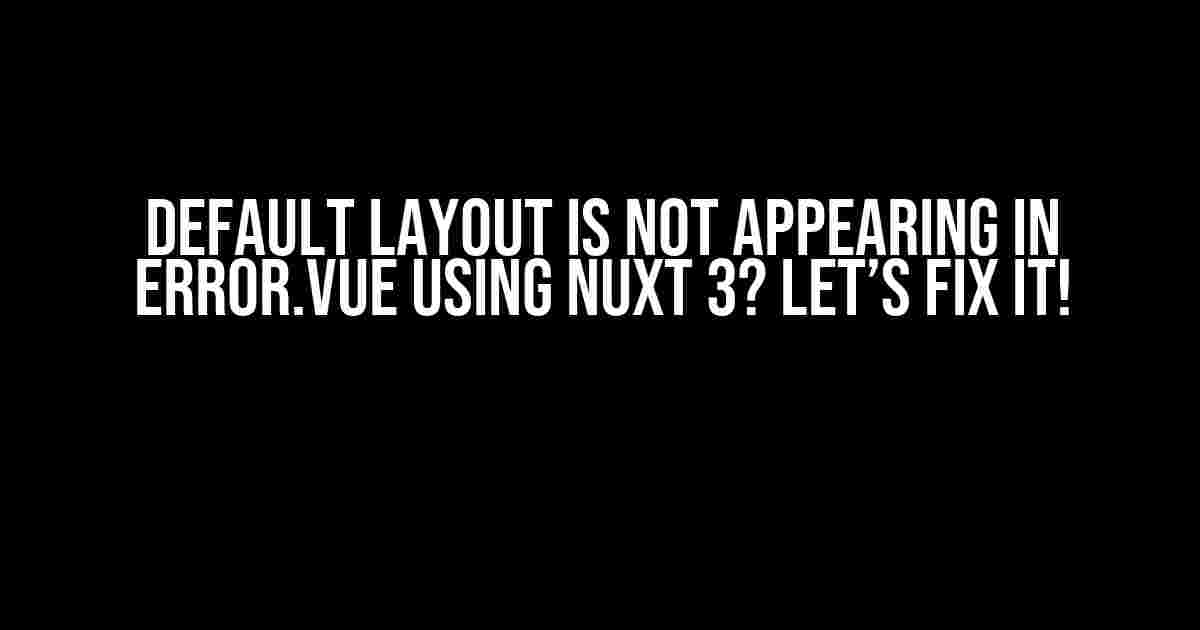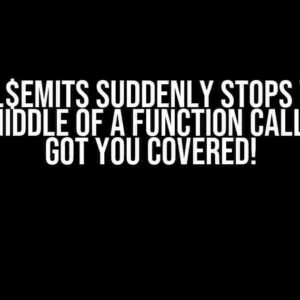Hey there, fellow Nuxt enthusiasts! If you’re stuck with the frustrating issue of the default layout not appearing in your error.vue file using Nuxt 3, you’re in the right place. In this article, we’ll dive into the possible causes, explore troubleshooting steps, and provide clear instructions to get you back on track.
The Mysterious Case of the Missing Default Layout
Before we dive into the solutions, let’s quickly review the expected behavior. In a Nuxt 3 project, the default layout is typically defined in the `layouts/default.vue` file. When an error occurs, Nuxt should automatically render the error.vue file, which inherits the default layout. However, in some cases, the default layout might not appear as expected.
Cause #1: Incorrect File Structure
One common mistake is incorrect file structure. Make sure your project follows the standard Nuxt 3 directory structure:
-my-project -pages -index.vue -about.vue -error.vue -layouts -default.vue -app.vue -nuxt.config.js -package.json
Verify that your `error.vue` file is located inside the `pages` directory, and the `default.vue` file is inside the `layouts` directory.
Cause #2: Misconfigured Nuxt Config
Another possible cause is an incorrect or incomplete Nuxt configuration. Check your `nuxt.config.js` file to ensure it includes the necessary settings:
export default {
//... other config options ...
layout: 'default', // or 'layouts/default' depending on your setup
errorPage: 'error',
//... other config options ...
}
Verify that the `layout` property is set to the correct value, and the `errorPage` property is set to `’error’` (or the name of your custom error page).
Cause #3: Custom Error Page Issues
If you’ve created a custom error page, ensure it’s correctly defined and imported. Check your `error.vue` file for any syntax errors or typos:
<template>
<div>
<h1>Error {{ statusCode }}</h1>
<p>An error occurred.</p>
</div>
</template>
<script>
export default {
props: {
error: {
type: Object,
default: null
}
}
}
</script>
Make sure your custom error page imports and uses the `default` layout correctly:
<template>
<div>
<default-layout>
<!-- your error page content -->
</default-layout>
</div>
</template>
<script>
import DefaultLayout from '~/layouts/default.vue'
export default {
components: { DefaultLayout }
}
</script>
Troubleshooting Steps
Try the following steps to troubleshoot the issue:
- Check the Nuxt dev tools console for any errors or warnings related to the layout or error page.
- Verify that your `error.vue` file is being rendered correctly by adding a temporary `console.log` statement inside the file.
- Try removing any custom layouts or templates to isolate the issue.
- Test your application in a different environment or browser to rule out any client-side issues.
Solution #1: Define a Custom Error Layout
If none of the above steps resolve the issue, you can define a custom error layout to ensure the default layout is applied:
// layouts/error.vue
<template>
<default-layout>
<!-- your error page content -->
</default-layout>
</template>
<script>
import DefaultLayout from '~/layouts/default.vue'
export default {
components: { DefaultLayout }
}
</script>
Then, update your `nuxt.config.js` file to use the custom error layout:
export default {
//... other config options ...
errorPage: 'error',
layout: 'error', // or 'layouts/error' depending on your setup
//... other config options ...
}
Solution #2: Use the `error` Property in Nuxt Config
Alternatively, you can define the error layout directly in your `nuxt.config.js` file using the `error` property:
export default {
//... other config options ...
error: {
layout: 'default', // or 'layouts/default' depending on your setup
statusCode: 500
},
//... other config options ...
}
This approach allows you to specify the error layout and status code directly in your Nuxt configuration.
Conclusion
In conclusion, the default layout not appearing in error.vue using Nuxt 3 can be caused by various factors, including incorrect file structure, misconfigured Nuxt config, or custom error page issues. By following the troubleshooting steps and solutions outlined in this article, you should be able to resolve the issue and get your error page rendering correctly with the default layout.
Remember to double-check your file structure, Nuxt config, and custom error page definitions. If you’re still stuck, feel free to ask for help in the Nuxt community or provide more details about your project for further assistance.
| Cause | Solution |
|---|---|
| Incorrect File Structure | Verify file structure and ensure correct placement of error.vue and default.vue files. |
| Misconfigured Nuxt Config | Check nuxt.config.js for correct layout and errorPage settings. |
| Custom Error Page Issues | Verify custom error page definition and ensure correct import and use of default layout. |
| Unknown Error | Define a custom error layout or use the error property in nuxt.config.js to specify the error layout. |
I hope this article has helped you resolve the issue and get your Nuxt 3 project back on track. Happy coding!
Frequently Asked Question
Having trouble with Nuxt 3 and error.vue? You’re not alone! Here are some FAQs to get you back on track.
Why is the default layout not appearing in error.vue using Nuxt 3?
In Nuxt 3, the default layout is no longer automatically applied to error.vue. To fix this, you need to explicitly define the layout in your error.vue file using the `layout` property. For example: `
`. This tells Nuxt to use the `my-layout` layout for your error page.
How do I define a custom layout for error.vue in Nuxt 3?
To define a custom layout for error.vue, create a new file in your `layouts` directory (e.g., `error-layout.vue`) and define your custom layout markup inside it. Then, in your error.vue file, specify the `layout` property and point it to your custom layout file. For example: `
`. This tells Nuxt to use your custom `error-layout` layout for your error page.
What if I want to use the default layout for error.vue in Nuxt 3?
If you want to use the default layout for error.vue, you can simply omit the `layout` property in your error.vue file. Nuxt will automatically use the default layout for your error page. However, keep in mind that this might not work as expected if you have a custom layout defined in your `nuxt.config.js` file.
Can I use a nested layout for error.vue in Nuxt 3?
Yes, you can use a nested layout for error.vue in Nuxt 3. To do this, create a new layout file that extends your default layout (e.g., `error-layout.vue` that extends `default.vue`). Then, in your error.vue file, specify the `layout` property and point it to your nested layout file. For example: `
`. This tells Nuxt to use your nested `error-layout` layout for your error page.
What if I’m still having trouble with the default layout in error.vue using Nuxt 3?
If you’re still having trouble, try checking your `nuxt.config.js` file to ensure that you haven’t accidentally overridden the default layout. Also, make sure that your custom layout files are correctly defined and referenced in your error.vue file. If all else fails, try debugging your Nuxt 3 app to see where the issue lies.



